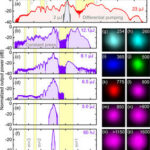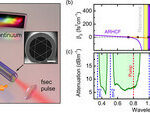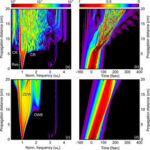- Home
- Research
- Fiber Research and Technology
- Research results
- Multi-Octave Supercontinuum Generation in Resonance-Enhanced Anti-Resonant Hollow-Core Fibers
Multi-Octave Supercontinuum Generation in Resonance-Enhanced Anti-Resonant Hollow-Core Fibers

23.04.2018
We will demonstrate a novel method of generating a multi-octave supercontinuum in a krypton gas-filled anti-resonant hollow-core fiber by employing its unique dispersion properties close to the strand resonance wavelength. An anti-resonant hollow-core fiber is produced and pumped with a Ti:Sa laser close to the resonance wavelength yielding a more than triple-octave supercontinuum spectrum via accelerated soliton fission. [1]
By: Rudrakant Sollapur // Daniil Kartashov // Michael Zürch // Andreas Hoffmann // Teodora Grigorova // Gregor Sauer // Alexander Hartung // Anka Schwuchow // Jörg Bierlich // Mario Chemnitz // Markus A Schmidt // Christian Spielmann // Jens Kobelke
Anti-resonant hollow-core fibers (ARHCFs) offer a variety of advantages over conventional solid core-clad fibers resulting in a low loss, broadband transmission spectrum. The thin strands of ARHCFs act as a Fabry-Perot (FP) cavity, and the reflections from the FP guide the light through the fiber. Due to the geometry of the fiber design, the higher-order core modes are phase matched with cladding modes; the fundamental core mode is anti-matched with cladding modes to always ensure fundamental core mode propagation.
The production of ARHCFs relied on the stacking of six thin-walled capillaries into a jacket tube and the drawing of this arrangement into a cane and fiber. The ends of the fiber were placed in two independent gas cells. The input end of the fiber was maintained in a vacuum, and the output end of the fiber was filled with 6 bars of krypton gas, maintaining the pressure gradient along the fiber. This configuration supported high input energy operation without damaging the fiber geometry. Fig. 1a shows the experimental setup and fiber cross section. The propagating fundamental mode experiences a sudden variation in dispersion by a few orders of magnitude (shown in Fig. 1b) closer to the resonance wavelength region, which provides an additional degree of freedom in dispersion management and opens a new regime of soliton dynamics. This design allows for an accurate and targeted spectral position of the resonances, enabling the up-scaling of the core diameter without drastic changes to the dispersion landscape.
This work presents a new efficient ultra-broadband supercontinuum generation of more than three octaves between the UV and near-infrared (NIR) range. Above a certain threshold, where the spectral broadening enters the resonance spectral region, the onset of super broadening is observed (see Figs. 2d and 2e). Figure 3 compares the simulation results of an ARHCF and a Kagome fiber, which have the same cross section and variation in temporal and spectral evolution of the pulse propagation. It is clearly observed that coherent non-adiabatic soliton dynamics and multiple Cherenkov radiation generation events influence multi-octave supercontinuum generation due to strong structural resonance. This efficient spectral broadening also overcomes the lossy resonance region (shown in Fig. 1c) providing continuous spectral output from the ultra-violet (200 nm) to near infrared (1700 nm) range.
In summary, we successfully introduced the concept of modal dispersion engineering in gas-filled ARHCFs via structural resonances, proving a new degree of freedom to obtain sophisticated dispersion landscapes. This new dispersion design enables the generation of multi-octave supercontinua spanning from deep UV wavelengths to near infrared wavelengths with high spectral density. This technique can be upscaled to the millijoule level by the design of large-core ARHCFs because the dispersion profile is independent of the core diameter due to the strand resonance. Simulations provide qualitative agreement to experimental results and show that the strongly varying group velocity dispersion in the vicinity of the strand resonance plays a major role, outperforming the dispersion of the gas and paving the way for the accelerated fission process of soliton-like waveforms and further emission of multiple phase-matched resonant Cherenkov radiation bands on both sides of the structural resonance.
This unique spectral broadening mechanism can reach either deep ultra-violet or mid-infrared wavelengths with applications in highly relevant areas like spectrally-resolved imaging, wide-field spectroscopy, and biophotonics.
Funded by: DFG, Thuringia, Humboldt Foundation



